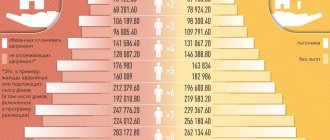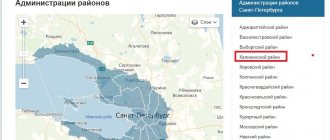Formula and calculator
The electricity calculator will calculate how much residents of St. Petersburg and the Leningrad region need to pay for electricity. Rates are listed below. If you have a single-tariff system, you just need to fill out the first three fields and click on the “calculate” button. If the system is two-tariff, fill out six fields; if it is a three-tariff system, then fill in all nine.
To calculate how much to pay for electricity, you need to take readings at the beginning of the billing period and at the end. Subtract the first from the second value. This figure shows how much electricity you burned. Then you multiply the resulting number by your tariff and get the amount to pay.
S=(AB) x C, where
S — amount to be paid
A - meter reading now
B - meter readings for the previous (already paid) period
C - tariff.
If you have a two- or three-tariff system, you need to calculate the amount for each tariff separately and add it up.
You can download current tariffs HERE.
Who determines the cost of electricity
The body responsible for determining the cost of electricity prices in the Leningrad region is the Committee on Tariffs and Pricing Policy. It is his orders that establish the current rates for payment of utility services, which can be found at the authority.
It is worth noting that electricity tariffs in the Leningrad region in 2020 are calculated on a half-year basis. If necessary, you can find out which rates are valid from January 1, 2021, and which are relevant from July 1 of the current year. But they will change (increase) once, in the second half of the year.
Find out more about who sets utility rates.
One-rate tariff for electricity in St. Petersburg
| from 01/01/2021 to 30/06/2021 | from 07/01/2021 to 12/31/2021 | |
| Indicator (consumer groups broken down by rates and differentiated by day zones) | Price (tariff) in rub./kWh | Price (tariff) in rub./kWh |
| 1. Urban population | ||
| Around the clock | 4.82 | 4.98 |
| 2. Population living in houses equipped with stationary electric stoves | ||
| Around the clock | 3.61 | 3.73 |
| 3. Consumers equal to the rural population | ||
| Around the clock | — | — |
| 4. Gardening, gardening or dacha non-profit associations of citizens | ||
| Around the clock | 4.82 | 4.98 |
| 5. Religious organizations maintained at the expense of parishioners | ||
| Around the clock | 4.82 | 4.98 |
| 6. Electricity consumers in outbuildings (cellars, sheds) | ||
| Around the clock | 4.82 | 4.98 |
Day-night tariff
The two-phase method of calculating electricity is otherwise called the day-night tariff. It operates in many regions of our country, but tariffs for the population vary. The differentiated regime is especially popular in the capital. It is beneficial to people who:
- actively use powerful electrical appliances, such as bread makers, boilers, dishwashers;
- equipped their apartments with warm floors or a convection heating system;
- have large country houses with an extensive lighting system, well or sewage pump, etc.
Tariff for two zones (peak and half-peak) in St. Petersburg
| from 01/01/2021 to 30/06/2021 | from 07/01/2021 to 12/31/2021 | |
| Indicator (consumer groups broken down by rates and differentiated by day zones) | Price (tariff) in rub./kWh | Price (tariff) in rub./kWh |
| 1. Urban population | ||
| Daytime zone (peak and half-peak) | 5.42 | 5.71 |
| Night zone (peak and half-peak) | 3.12 | 3.15 |
| 2. Population living in houses equipped with stationary electric stoves | ||
| Daytime zone (peak and half-peak) | 4.06 | 4.28 |
| Night zone (peak and half-peak) | 2.34 | 2.36 |
| 3. Consumers equal to the rural population | ||
| Daytime zone (peak and half-peak) | — | — |
| Night zone (peak and half-peak) | — | — |
| 4. Gardening, gardening or dacha non-profit associations of citizens | ||
| Daytime zone (peak and half-peak) | 5.42 | 5.71 |
| Night zone (peak and half-peak) | 3.12 | 3.15 |
| 5. Religious organizations maintained at the expense of parishioners | ||
| Daytime zone (peak and half-peak) | 5.42 | 5.71 |
| Night zone (peak and half-peak) | 3.12 | 3.15 |
| 6. Electricity consumers in outbuildings (cellars, sheds) | ||
| Daytime zone (peak and half-peak) | 5.42 | 5.71 |
| Night zone (peak and half-peak) | 3.12 | 3.15 |
Disadvantages of the night tariff
The differential tariff has not only advantages. The multi-tariff system also has several disadvantages:
- With the increase in nighttime electricity consumption, users have to monitor the operation of home appliances in the dark. As a result, a person’s daily sleep and wakefulness patterns are disrupted, which is fraught with health problems.
- If devices are left to operate unattended, there is a high risk of fire or flooding.
- Noisy household appliances, such as a washing machine, can prevent neighbors or family members from getting a good night's sleep.
Another disadvantage is the initial cost of installing a new meter. However, when using a two-tariff meter, the savings are so great that they will pay for themselves in the first year.
Tariff for three zones (peak, half-peak, night) in St. Petersburg
| from 01/01/2021 to 30/06/2021 | from 07/01/2021 to 12/31/2021 | |
| Indicator (consumer groups broken down by rates and differentiated by day zones) | Price (tariff) in rub./kWh | Price (tariff) in rub./kWh |
| 1. Urban population | ||
| Peak zone | 5.45 | 5.74 |
| Half-peak zone | 4.82 | 4.98 |
| Night zone | 3.12 | 3.15 |
| 2. Population living in houses equipped with stationary electric stoves | ||
| Peak zone | 4.11 | 4.33 |
| Half-peak zone | 3.61 | 3.73 |
| Night zone | 2.34 | 2.36 |
| 3. Population living in rural settlements and those equivalent to them. | ||
| Peak zone | — | — |
| Half-peak zone | — | — |
| Night zone | — | — |
| 4. Gardening, gardening or dacha non-profit associations of citizens | ||
| Peak zone | 5.45 | 5.74 |
| Half-peak zone | 4.82 | 4.98 |
| Night zone | 3.12 | 3.15 |
| 5. Religious organizations maintained at the expense of parishioners | ||
| Peak zone | 5.45 | 5.74 |
| Half-peak zone | 4.82 | 4.98 |
| Night zone | 3.12 | 3.15 |
| 6. Electricity consumers in outbuildings (cellars, sheds) | ||
| Peak zone | 5.45 | 5.74 |
| Half-peak zone | 4.82 | 4.98 |
| Night zone | 3.12 | 3.15 |
In rural areas, electricity is charged differently. St. Petersburg pays 30% more than the province. The calculation is made in kWh, based on the same indicators as in cities.
Advantages of night tariff for electricity
The advantages of the preferential tariff are obvious:
- Electricity consumers can achieve good cash savings. To do this, you need to adjust your regime, reducing daytime, but increasing nighttime electricity consumption.
- Suppliers are able to reduce the load on equipment, resulting in less wear and tear and fewer breakdowns. This allows you to save budget funds.
- Evenly distributed load on electrical grids is a good way to save the fuel needed to produce energy.
- Due to the absence of overloads, the amount of emissions of harmful substances into the atmosphere is reduced.
- Modern metering devices are equipped with built-in memory modules. They allow you to save meter readings even if there is a power outage.
However, users should note that different cities have different preferential rates. Before switching to a differential system, experts recommend making calculations and finding out how profitable such a solution is. If only the refrigerator operates in the house at night, the consumer should think about the need for a two-tariff system. Before the transition, you should calculate how long it will take to pay off the costs of new equipment and electrician services.
One-rate tariff for electricity in the Leningrad region
| from 01/01/2021 to 30/06/2021 | from 07/01/2021 to 12/31/2021 | |
| Indicator (consumer groups broken down by rates and differentiated by day zones) | Price (tariff) in rub./kWh | Price (tariff) in rub./kWh |
| 1. Urban population | ||
| Around the clock | 4,48 | 4,70 |
| 2. Population living in houses equipped with stationary electric stoves | ||
| Around the clock | 3,32 | 3,48 |
| 3. Consumers equal to the rural population | ||
| Around the clock | 3,27 | 3,43 |
| 4. Gardening, gardening or dacha non-profit associations of citizens | ||
| Around the clock | 4,48 | 4,70 |
| 5. Religious organizations maintained at the expense of parishioners | ||
| Around the clock | 4,48 | 4,70 |
| 6. Electricity consumers in outbuildings (cellars, sheds) | ||
| Around the clock | 4,48 | 4,70 |
Compensation for losses in SNT power grids: judicial practice
Let's consider the indicative court decision in the case of “inflated” electricity tariffs in SNT.
A resident of the Krasnoyarsk Territory appealed to one of the local district courts with a claim against her SNT “Agrarnik”. In the statement of claim, the woman demanded to cancel the decision of the general meeting of SNT members, which set an inflated (from her point of view) electricity tariff of 2 rubles. for 1 kWh. Despite the fact that in the Krasnoyarsk Territory at that time (2012) the tariff for the population was only 1.6 rubles. per kWh
In the court proceedings, a representative of SNT stated that the decision to assign an increased tariff was made in order to cover losses arising in the electricity networks and transformers of the partnership. Their volume is 5.2%. According to the SNT representative, the decisions made did not contradict the current legislation, since payment was made for the amount of energy actually received by the subscriber in accordance with energy metering data.
However, the court did not agree with this point of view. The court decision states that the current legislation (namely, Order of the Federal Tariff Service dated August 6, 2004 N 20-e/2 “On approval of guidelines for calculating tariffs and prices for electricity and heat in the retail consumer market” ) horticultural non-profit associations are equated (in terms of electricity tariffs) to the “population” category.
In this case, the decision on the size of the electricity tariff for the population is made by the authorized regional executive body. In the case of the Krasnoyarsk Territory - the Regional Energy Commission (REC). And payment for electricity consumption by SNT members must be made precisely at the tariff approved by the Krasnoyarsk Regional Energy Commission.
On the part of SNT, objections were presented at the trial in the sense that 2 rubles. per kWh This is not a tariff, but a “payment for electricity”. It is established as a “comprehensive indicator for settlements within a gardening partnership”, with its help the costs of losses and maintenance of the partnership’s electrical networks are covered, and this is not at all the same as the regional electricity tariff.
The court did not agree with this interpretation. A tariff, from a judge’s point of view, is a tariff. It is used to pay for consumed electricity. And fees for maintaining networks and covering losses should be charged through special additional fees.
As a result, the SNT member’s application to cancel the inflated tariff was granted. You can read the court's decision in full at this link.
There are quite a lot of such solutions. And, despite this, practice shows that gardening associations still en masse set their own “internal” inflated electricity tariffs.
The latest news on this topic is the results of an inspection by the prosecutor's office of the Nizhny Novgorod region of compliance with the law when paying for electricity in gardening associations in the region. In total, about forty cases of establishing an “inflated” electricity tariff in SNT were identified. Their chairmen received recommendations from the prosecutor's office to eliminate the identified violations.
Electricity tariff for two zones in the Leningrad region
| from 01/01/2021 to 30/06/2021 | from 07/01/2021 to 12/31/2021 | |
| Indicator (consumer groups broken down by rates and differentiated by day zones) | Price (tariff) in rub./kWh | Price (tariff) in rub./kWh |
| 1. Urban population | ||
| Daytime zone (peak and half-peak) | 4,71 | 4,96 |
| Night zone (peak and half-peak) | 2,55 | 2,68 |
| 2. Population living in houses equipped with stationary electric stoves | ||
| Daytime zone (peak and half-peak) | 3,48 | 3,67 |
| Night zone (peak and half-peak) | 1,88 | 1,98 |
| 3. Consumers equal to the rural population | ||
| Daytime zone (peak and half-peak) | 3,43 | 3,62 |
| Night zone (peak and half-peak) | 1,85 | 1,95 |
| 4. Gardening, gardening or dacha non-profit associations of citizens | ||
| Daytime zone (peak and half-peak) | 4,71 | 4,96 |
| Night zone (peak and half-peak) | 2,55 | 2,68 |
| 5. Religious organizations maintained at the expense of parishioners | ||
| Daytime zone (peak and half-peak) | 4,71 | 4,96 |
| Night zone (peak and half-peak) | 2,55 | 2,68 |
| 6. Electricity consumers in outbuildings (cellars, sheds) | ||
| Daytime zone (peak and half-peak) | 4,71 | 4,96 |
| Night zone (peak and half-peak) | 2,55 | 2,68 |
Payment for electricity and the new law on SNT
It is also worth mentioning that from January 1, 2021, a new law on gardening associations comes into force (Federal Law of July 29, 2021 N 217-FZ “On the conduct of gardening by citizens for their own needs and on amendments to certain legislative acts Russian Federation").
This document brings greater clarity to the issue that interests us. In particular, paragraph 5 of Art. 14 of the law, among the types of membership fees in a gardening association, the following are separately listed:
- contributions settlements with suppliers of heat and electricity, water, gas, sanitation on the basis of agreements concluded with these organizations;
- contributions for the maintenance of the partnership's common property.
Thus, the division of electricity payments in gardening associations into two components - payments for actually consumed electricity and a contribution to pay for losses in networks - becomes more obvious.
Electricity tariff for three zones in the Leningrad region
| from 01/01/2021 to 30/06/2021 | from 07/01/2021 to 12/31/2021 | |
| Indicator (consumer groups broken down by rates and differentiated by day zones) | Price (tariff) in rub./kWh | Price (tariff) in rub./kWh |
| 1. Urban population | ||
| Peak zone | 5,37 | 5,64 |
| Half-peak zone | 4,48 | 4,70 |
| Night zone | 2,55 | 2,68 |
| 2. Population living in houses equipped with stationary electric stoves | ||
| Peak zone | 3,98 | 4,18 |
| Half-peak zone | 3,32 | 3,48 |
| Night zone | 1,88 | 1,98 |
| 3. Population living in rural settlements and those equivalent to them. | ||
| Peak zone | 3,92 | 4,13 |
| Half-peak zone | 3,27 | 3,43 |
| Night zone | 1,85 | 1,95 |
| 4. Gardening, gardening or dacha non-profit associations of citizens | ||
| Peak zone | 5,37 | 5,64 |
| Half-peak zone | 4,48 | 4,70 |
| Night zone | 2,55 | 2,68 |
| 5. Religious organizations maintained at the expense of parishioners | ||
| Peak zone | 5,37 | 5,64 |
| Half-peak zone | 4,48 | 4,70 |
| Night zone | 2,55 | 2,68 |
| 6. Electricity consumers in outbuildings (cellars, sheds) | ||
| Peak zone | 5,37 | 5,64 |
| Half-peak zone | 4,48 | 4,70 |
| Night zone | 2,55 | 2,68 |
Useful article? Rate and share with friends!










